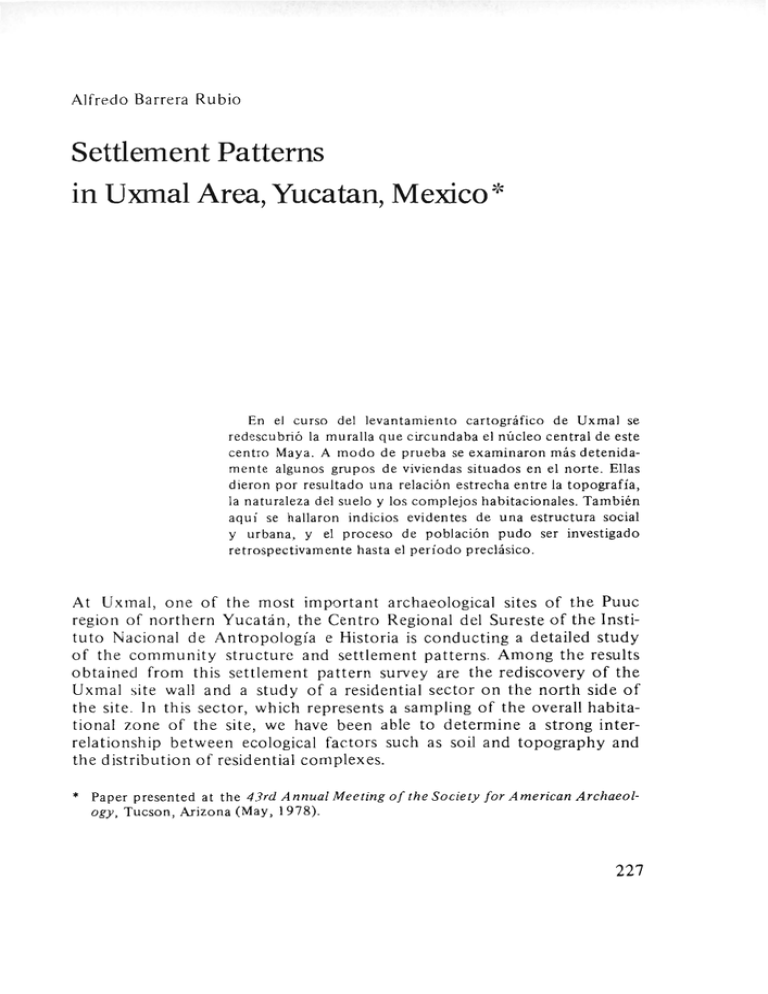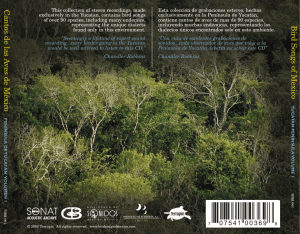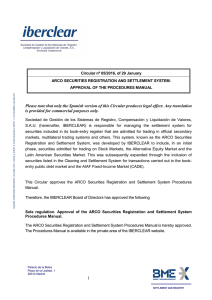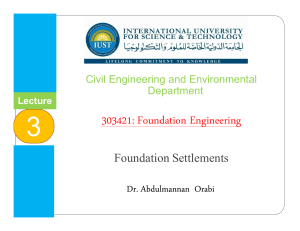Settlement Patterns in Uxmal Area, Yucatan, Mexico*
Anuncio

Alfredo Barrera Rubio Settlement Patterns in Uxmal Area, Yucatan, Mexico* En el curso del l e v a n t a m i e n t o c a r t o g r á f i c o de U x m a l se r e d e s c u b r i ó la muralla q u e c i r c u n d a b a el n ú c l e o central de este c e n t r o Maya. A m o d o de p r u e b a se e x a m i n a r o n m á s d e t e n i d a m e n t e algunos g r u p o s de viviendas situados en el n o r t e . Ellas d i e r o n p o r resultado una relación estrecha entre la t o p o g r a f í a , la naturaleza del suelo y l o s c o m p l e j o s habitacionales. T a m b i é n a q u í se hallaron i n d i c i o s evidentes de una estructura social y urbana, y el p r o c e s o de p o b l a c i ó n p u d o ser investigado r e t r o s p e c t i v a m e n t e hasta el p e r í o d o p r e c l á s i c o . At Uxmal, one o f the most important archaeological sites o f the Puuc region of northern Yucatán, the Centro Regional del Sureste o f the Instituto Nacional de Antropología e Historia is conducting a detailed study o f the community structure and settlement patterns. Among the results obtained from this settlement pattern survey are the rediscovery o f the Uxmal site wall and a study o f a residential sector on the north side o f the site. In this sector, which represents a sampling o f the overall habitational zone o f the site, we have been able to determine a strong interrelationship between ecological factors such as soil and topography and the distribution o f residential complexes. • Paper presented at the 43rd Annual Meeting of the Society ogy, for American Archaeol- Tucson, Arizona (May, 1978). 227 Considering the extent o f the residential zone, the highly nucleated character o f the remains, and clearcut evidence o f social stratification we believe that the community reflects a number o f features showing an urban character. Also, the ceramics f r o m the survey attest to a long span o f occupation at the site, beginning in Formative times. As an ecological zone, the Uxmal area offers a number o f advantages for human settlement; most important is the quality o f the soil, which is highly fertile and is found in deep deposits around the site. On the other hand, the scarcity o f water in the region posed a serious problem f o r human settlers; the Puuc region lacks cenotes and rivers, and offers only a few scattered aguadas or waterholes, most o f which are dry during several months o f the year. The Maya o f Uxmal overcame the water problem by building chultunes, or underground cisterns, f o r purposes o f rainwater storage; in our limited survey we have plotted over 122 o f these (Barrera Rubio 1977a and G o n zález Fernández 1977), in an area o f approximately one square kilometer; these are found in plazas at the center o f the site, and in terraces and platforms in the residential zone. The stagnant water in the seasonal aguadas in the area were a likely supply o f water for construction purposes, but were probably not major sources o f potable water. Archaeological surveys in the Puuc area in the past have paid scant attention to settlement patterns. Chroniclers, travelers and explorers have waxed eloquent on the beauty and monumentality o f the architectural remains o f Puuc sites; work in recent years has concentrated almost exclusively on the consolidation and conservation o f these remains. Reports on the residential areas have been superficial and few and far between; the first such observation was made by Edward H. T h o m p s o n ( 1 8 8 6 : 2 5 2 f.), who reported a number o f small mounds and platforms in the vicinity o f Labná, and consequently deduced that these were the foundations f o r perishable residential structures. Much later Karl Ruppert and Ledyard Smith ( 1 9 5 7 : 5 8 0 - 5 8 4 ) reported several residential clusters at Uxmal, Kabah, Sayil and Chacchob. At Uxmal they made a sketch map o f 33 isolated structures o n the south side o f the site next to the road to San Simón. Aside f r o m these brief reports, settlement pattern studies at the site level in the Puuc area are nonexistent. The absence o f settlement pattern data in one o f the most important archaeological regions in the northern Mayan Lowlands prompted our survey and the selection o f Uxmal as an excellent site for a case study. Our project is conducted under the premise that settlement patterns reflect the e c o n o m i c and social structure o f the community and its 228 adaptation to the surrounding natural habitat. In the case o f Uxmal we have determined that the diversity and distribution o f residential structures, the energy cost invested into their construction, their proximity to goods and services areas, water cisterns and fertile soil, all provide indications o f social stratification and community organization at Uxmal. In addition, preliminary reconnaissance of the outlying areas is under way, with the objective of establishing links between the site proper and minor secondary centers in the periphery; this will enable us to provide a preliminary sketch o f the political organization at the regional level. The project began with the detailed mapping o f the civic ceremonial center, including all major structures not marked on previous maps o f the site. In the course of this mapping we relocated the wall around the central part of the site which was partly mapped on its west side by Stephens and Catherwood in 1 8 4 1 - 1 8 4 2 (Stephens 1843, I: 165); later reports of the wall were made by Eligió Ancona in 1878 (1978: 85) and César Sáenz(1972: 36). These reports only provide incomplete data o f the wall which we have now mapped in its entirety; this was made possible with the help o f detailed 1 : 20,000 scale airphotos o f the site provided by the Compañía Mexicana de Aereofoto (Fig. 1). The wall has an irregular elliptical plan; the north-south axis is approximately one kilometer long, and the east-west axis measures approximately 600 meters. Most of the major buildings are located inside the wall. The west and south sides o f the wall are fairly well preserved, while sections along the north and east sides have been destroyed by the construction o f the modern highway and tourist facilities. Similar walls have been reported from several sites in northwestern Yucatán; at Aké, Muna anc Chunchucmil; these walls have been dated to the Pure Florescent period ( 8 0 0 - 1000 A . D . ; Kurjack and Andrews 1976: 322). Our test pitting in the Uxmal wall indicates a similar date of construction (Gonzáles Fernández 1977). Most of the major buildings of the civic ceremonial center are located inside the wall. The same is true for the above mentioned sites. At Uxmal, our general impression is that the wall encloses the central precinct in which the elite lived; this was the seat o f government, and the nucleus o f economic activity in the city. Beyond the wall lived the minor functionaries and servants o f the elite, along with the majority of the population, composed by peasants who provided the economic foundations for the city. The settlement pattern survey o f this area reflects an efficient adaptation to the surrounding habitat. As mentioned above there is a clear interdependence between topographical features, soil types and human settlement patterns. 229 In the Uxmal area there are three major different soil types, called in the Mayan language: Pusluum, Kankab and Akalché. Pusluum is a reddish brown soil (Munsell 1975: 5 Y R 4 / 3 ) , which is reputed to be the most fertile o f the region for seasonal agriculture; it is always f o u n d on hillsides and natural rises with g o o d drainage. Kankab is a dark red soil (Munsell 1975: 2.5 Y R 3 / 6 ) f o u n d in flat lands without g o o d drainage. Akalché soils are light olive brown b o t t o m soils (Munsell 1975: 2.5 Y 5 / 4 ) and are o f t e n the receptacles o f seasonal aguadas. In our survey we f o u n d that all the residential complexes were located in Xhs. Pusluum soil areas (Fig. 2). However, the Kankab and Akalché areas were also exploited, as they still are today. Several colonial sources indicate that the Maya exploited several kinds o f soil types and microenvironmental areas simultaneously; certain areas o f the Puuc were reputed to have produced two crops a year ( R Y , I: 138, 207). These sources and other data imply that the Puuc region was the foodbasket o f northern Yucatán (Patch 1977: 63). In the area in which we mapped most o f the residential structures we f o u n d a great variety o f residential types; most prominent were large platform complexes supporting vaulted buildings and assorted perishable structures. These complexes also incorporated most o f the chultunes located in the survey, some o f which have rehef carvings in their interior walls (Fig. 3). Other complexes are characterized by small platforms without vaulted buildings; these rarely have chultunes. Finally, at the b o t t o m o f the social scale, we have isolated foundations o f apsidal and round structures which lack chultunes altogether. Excavations in the residential areas did uncover ceramics which date to Formative and Terminal Classic (Pure Florescent) times. The lowest levels o f the excavations contained wares characteristic o f Smith's Tihosuco c o m p l e x (Yucatán opaque ware. N o l o Red and Ucu Black groups). These formative wares represent approximately 10 % o f the sample. The primary period o f occupation was during the Pure Florescent, as most o f our ceramics are representative o f the Cehpech c o m p l e x . CONCLUSIONS The ultimate objective o f our project is to provide a general view o f the types o f settlement patterns that occur in this previously unsurveyed region in the northern Maya Lowlands. On the basis o f our work so far we would like to make t w o preliminary observations. 230 Our survey o f chultunes reflects a massive investment o f labor for purposes o f rainwater storage; on the other hand, the vast rainwater facilities indicated a precarious dependence o f the population on seasonal rainfall patterns. The primary association o f chultunes with-high status residential complexes also reflects elite control o f water deposits. Another fact that became apparent in the course o f our study was that the Uxmal settlement pattern is quite different from that o f other sites in northern Yucatán. At sites like Chunchucmil (Vlcek 1978), Dzibilchaltun (Kuijack 1974), Coba (Fletcher and Kintz 1977; Garduño 1977), Mayapán (Smith 1962), Cozumel (Freidel 1976) and Tulum (Barrera Rubio 1977), which are located on flat plains, the habitational zones tend to be evenly distributed over the landscape. In the hilly Puuc region the settlement pattern reflects an adaptation to the irregular terrain. At Uxmal residential complexes occur in nucleated clusters on elevated land areas. These grouping o f residential units on natural features also makes the use o f walls unnecessary, unlike the above mentioned sites, which have extensive networks o f such walls defined by features o f the terrain. We believe that Uxmal has an urban character similar to the above mentioned sites. What remains to be determined is whether the settlement pattern it exhibits reflects a different kind o f social structure o f merely an adaptation to a different type o f terrain. ACKNOWLEDGEMENTS This project is being conducted under the auspices o f the Centro Regional del Sureste o f the Instituto Nacional de Antropología e Historia de México. The director o f the project was Norberto González Crespo and the field work was directed by the author o f this paper; the mapping o f the site wall was undertaken by Baltazar González Fernández, and Teresa Ramayo Lanz was responsable for the excavation o f several o f the chultunes. Both are associated with the school o f A n t h r o p o l o g y o f the University o f Yucatán. I would like to thank Norberto González Crespo, Juan M. Andrews and A n t h o n y P. Andrews for their comments o n the preparation o f this paper. The latter translated the paper into English. 231 REFERENCES A n c o n a , Eligió 1978 Historia tán. de Yucatán. V o l . 1, 4th ed., Mérida: Universidad de Y u c a - Barrera R u b i o , A l f r e d o 1977 " E x p l o r a c i o n e s a r q u e o l ó g i c a s en T u l u m , Quintana R o o . " In Boletín de la Escuela de Ciencias Antropológicas, 4 ( 2 4 ) : 23 - 6 3 , Mérida. 1977a Unpublished INAH. Field Notes. Mérida: Centro Regional del Sureste, F l e t c h e r , Loraine A . , and Ellen B. Kintz 1977 " U n i n f o r m e preliminar, C o b á , Quintana R o o . " In Boletín de Escuela de Ciencias Antropológicas, 4 ( 2 2 / 2 3 ) : 7 2 - 8 1 , Mérida. Freidel, David 1976 la Late Postclassic Settlement Patterns on Cozumel Island, Quintana Roo, Mexico. Unpublished Dissertation, Harvard University ( D e p a r t m e n t o f A n t h r o p o l o g y ) , C a m b r i d g e , Mass. G a r d u ñ o A . , Jaime 1977 Unpublished INAH. Field Notes. Mérida: Centro Regional del Sureste, G o n z á l e z F e r n á n d e z , Baltazar 1977 Unpublished INAH. Field Notes. Mérida: Centro Regional del Sureste, K u r j a c k , E d w a r d B. 1974 Prehistoric Lowland Maya Community and Social Organization. A Case Study at Dzibilchaltun, Yucatán, México. N e w Orleans, La.: Tulane University, Middle A m e r i c a n Research Institute (Publication 3 8 ) . K u r j a c k , E d w a r d B., and E. W y l l y s A n d r e w s V 1976 " E a r l y Boundajry Maintenance in N o r t h w e s t Y u c a t a n , In American Antiquity, 4 1 . 3 : 3 1 8 - 3 2 5 , Washington. Munsell, L u k e 1975 Patch, R o b e r t 1977 232 Soil Color Charts. Mexico." Baltimore, Md. " E l m e r c a d o u r b a n o y la e c o n o m í a c a m p e s i n a en el siglo X V H I . " In Boletín de la Escuela de Ciencias Antropológicas, 5 (27): 52 6 6 , Mérida. RY 1898 - 1890 Relaciones inéditos las antiguas Sáenz, César A . 1972 al descubrimiento, posesiones "Exploraciones Boletín 2 vols., Madrid (Colección de Yucatán. relativos y del Instituto españolas en de documentos y organización de segunda serie, 11, 13). de Ultramar, restauraciones Nacional conquista Uxmal (1970 - de Antropología 1971)." e Historia, In segunda época, 2 : 3 1 - 40, México. Smith, A . L e d y a r d 1962 " R e s i d e n t i a l and A s s o c i a t e d Structures at M a y a p a n . " In Harry E. D. Pollok et al. (eds.); Mayapan, Yucatan, Mexico, Washington: Carnegie Institution (Publication pp. 165 — 277, 619). S m i t h , A . L e d y a r d , and Karl R u p p e r t 1957 House Types Sayil, Chicken in the Environs Itza, and of Mayapan Chacchob. t i o n , D e p t . A r c h a e o l o g y (Current and at Uxmal, Kabah, Washington: Carnegie Institu- Reports, 39). Smith, R o b e r t E. 1971 The Pottery of Mayapan. Including Studies of Ceramic Material from Uxmal, Kabah, and Chichen Itza. 2 vols., Cambridge, Mass.: Harvard University (Papers of the Peabody Museum, 66). Stephens, J o h n L, 1 843 Incidents of Travel in Yucatan. 2 vols., L o n d o n . T h o m p s o n , Edward H. 1886 " A r c h a e o l o g i c a l Research in Y u c a t a n . " In Proceedings ican Antiquarian V l c e k , David 1978 "Muros Society, de d e l i m i t a c i ó n of the Amer- n.s., 4: 248 — 254, Worcester. residencial en C h u n c h u c m i l . " de la Escuela de Ciencias Antropológicas, In Boletín 5 (28): 55 — 64, Mérida. 233 Fig. 1: Aerial p h o t o g r a p h o f U x m a l , Y u c a t á n . N o t e part o f the l o w wall e n c l o s i n g m u c h o f the central g r o u p . 234 Fig. 2 : U x m a l and its surroundings. H o u s e p l a t f o r m s are visible in the cleared fields, these are l o c a t e d southeast o f the civic c e r e m o n i a l center o f U x m a l . Fig. 3 : R e p r e s e n t a t i o n o f aquatic animals associated with the rain c u l t : s t u c c o basreliefs l o c a t e d o n an interior wall o f an u n d e r g r o u n d cistern that was f o u n d in an habitational p l a t f o r m in the n o r t h e r n sector o f U x m a l . ( D r a w n b y Henri Christopher Dunster) 235






